SCRIBBLE.SO
How to Write a Book in 30’ish Days
Can you write a book in 30 days? The answer is… probably. In this blog post we’ll explore the science behind writing productivity.
![]() Software version 1.8.0
Software version 1.8.0

How to Write a Book in 30 Days – The Science of Writing Productivity
Today I want to talk about a scientific strategy can can help you get your books completed ahead of schedule. If you want to learn how to write a book in under 30 days then begin by watching the video below.
How to Write a Book in Under a Month
Is it possible to write a book in under a month? We all know stories of famous Authors who finished their books quickly. For example:
– Kerouac’s – On the road was finished in about 3 weeks
– A Clockwork Orange, by Burgess was wrapped up in 3 weeks
– The Gambler by Dostoevsky was written in 28 days…. Mostly because he was addicted to gambling and had some debts that needed tended to, but hey… whatever gets you to the finish line.
Now, if you don’t know, we’re Scribble, a writing tool that helps writers create more compelling books and we’re a bit obsessed about writing productivity, so in today’s tutorial I’m going to show you strategies you can use to learn how to write a book, or at least a first draft, in under a month
When creating this tutorial I wanted to share with you writing productivity processes which have worked for me, but are also backed by science. Yale has a course online called “The Science of Well Being”. One section within that course covered the topic of goal setting and the science behind goal actualization. Professor Laurie Santos shares an assortment of studies that help us better understand why we behave the way we do with respect to our goals and she suggests various strategies we can use to improve the chances of actually reaching our goals.
So in today’s tutorial I want to apply those strategies to the world of writing, so that authors can use these techniques in order to get their books… well… finished.
Quantatitive Precision
Santos argues that “goal specificity” is important. This means writers need to train themselves to think in very specific ways. And in order to have specific goals as writers, we need to do a bit of math. Studying word counts and chapter breakdowns is one way for us to start to formulate a very specific writing goal.
The Math of Commercial Fiction
So first, let’s take a look at the math behind commercial literary fiction. Generally, and of course there are exceptions, but word counts tend to hover between 55,000 to 120,000 words.
Again, if we look at the examples from the beginning of this tutorial, those books, with the exception of The Gambler, fall within this range.
– A Clockwork Orange clocks in at around 60000 words
– On the Road hovers around 70,000 words
– The Gambler comes in at a lean 30,000 words.
Okay, so we know that books can sell with these words counts. But this is the still distant end goal. So let’s come up with something more specific by breaking this end word count into smaller goals. To do this I’m going to use SMART goal planning which is simply the creation of goals which are:
Specific,
Measurable
Achievable
Realistic
Time-bound
Now I’m going to jump over into Scribble and head over to a sample book and I’m going to go to my writing “productivity” section.
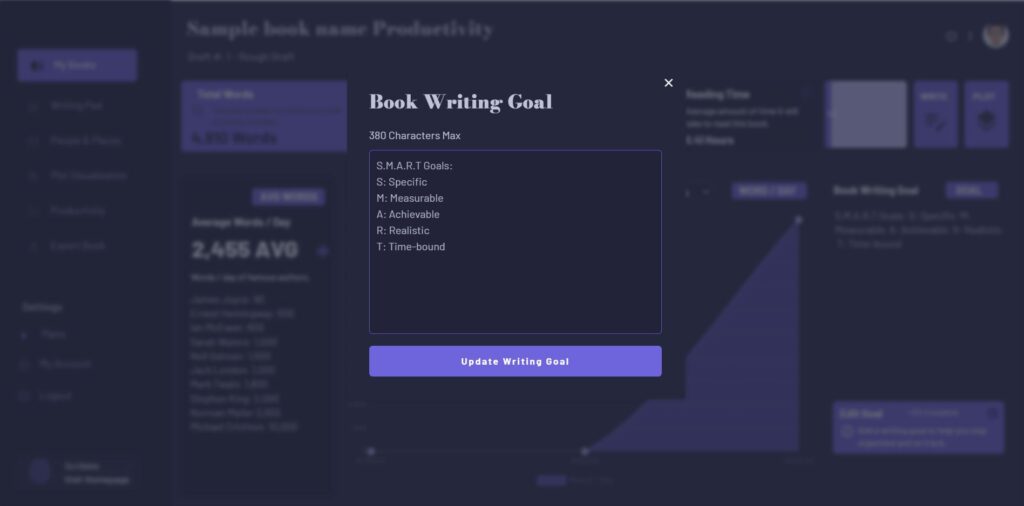
So I’m going to start by being specific. I’m going to write a 60,000 word novel, broken up into 24 chapters, each chapter with approximately 2500 words.
Next under measurable, I will measure based on my daily word count which will be 2500 / day. Keep in mind, that Scribble keeps track of my daily word count for me here. Also, on my chapter writing pages, I can see my chapter progress bar on my “writing pad” page, which helps me keep my eye on this metric in real time.
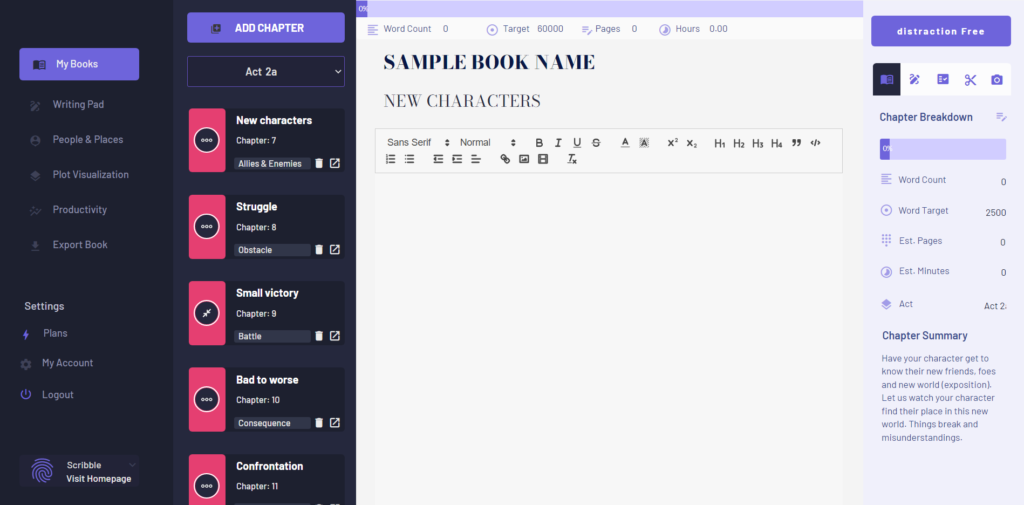
Next, under “achievable” I can write yes, because I can generally write 2500 words in between 2 – 6 hours.
It’s also a realistic goal for me, because I have 8 hours available / day to write this novel.
And lastly, under time bound I’ll write that I want to get a first draft of this novel written in 24 days. This means I would need to write 1 chapter / day, each one being 2500 words and I would need to do this every single day for 24 days to hit this goal.
The Science of WOOPing
Okay, so we’ve done some math and set up our SMART goals. Now, let’s get back to the science of goal setting and goal accomplishment.
In her course, the science of well being, Santos introduces her students to a technique called WOOP. WOOP is a four step process designed by psychologist Gabriele Oettingen. It’s an acronym that stands for: Wish, Outcome, Obstacles, and Plan.
It’s essentially a marrying of two scientifically-proven techniques called mental contrasting and implementation intentions.
In a nutshell, Mental contrasting is the process of seeing all sides of a goal. It’s not just about visualizing the positive experiences of achieving your goal, but it’s also about visualizing how you’ll deal with obstacles when they get in your way.
And the implementation intention technique is simply a self-regulatory strategy that allows you to protect yourself from automatic behavior when certain, often negative, situations arise. Think of it sort of like “If that, then this” programming that allows you to get through obstacles without requiring much will power.
The shocking thing is, even though these techniques are visualization techniques, there is a lot of empirical evidence to suggest these techniques work.
A couple of side notes here though. The data suggests that these techniques tend to work better as the difficulty of a goal increases. Below on the left you see the data which shows performance increase based on easy to implement goals. The difference is small. However, to the right, you see the performance increase of about 3X with respect to more challenging goals. Now I would argue that writing a book is a big difficult goal that would be included on the right side.
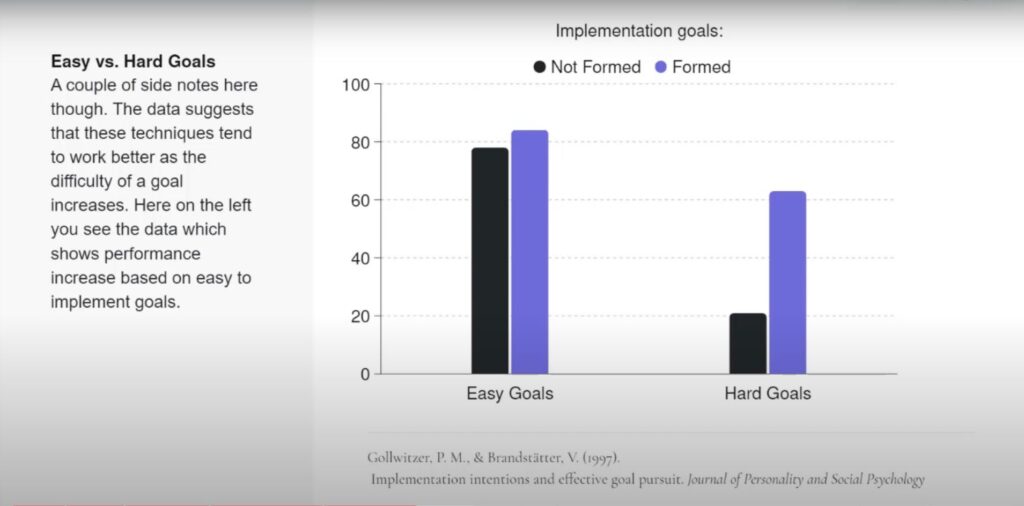
And secondly, the evidence also suggests that these techniques tend to work better the longer they are practiced. In another study, looking at physical activity goals, WOOP practitioners outperformed the control group by about 2X, but performance improvements were more noticeable after the 1 month mark.
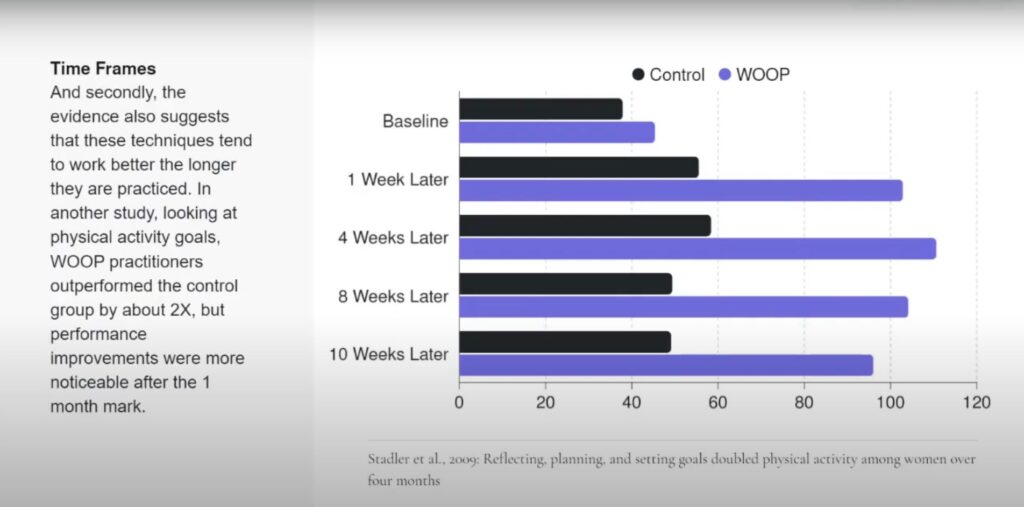
So let’s learn how to WOOP.
Wish
This first step in the WOOP process is to set specific goals. In order to do this you need to wish. You need to know, and visualize, specifically what you want in the next day, week, month or year. As we’ve talked about, the more specific the better. That’s why when we were setting up our smart goals, we broke it down to the daily word count and chapter targets. The importance of using specific goals cited study from 1990, which showed that chances of success increased as goals became more specific. Here is a link to that study.
Outcome
The second step of the WOOP process is outcome. The outcome step is a visualization step which helps you link a desired outcome to a wish. It’s important to make this visualization sensual. Again, be specific and detailed. Visualize textures, sents, sights and sounds. Spend a minute visualizing arriving at your final destination. This helps you associate a reward with your wish which is essential to maintain motivation.
Obstacles
The third step is focused on the obstacles you’ll face when pursuing your goal. It’s important to consider these obstacles because they can derail you if they catch you off guard. However, if you’ve predicted their arrival and pre-planned your response, you’ll be better able to handle the hurdles as they arrive. Here it’s important to consider internal and well as external obstacles.
This third step is also a visualization exercise, but for me, it helps when I write these obstacles down and practice them even when obstacles are not present. This way I’m conditioning myself to deal with these obstacles even before they arrive.
So ask yourself right now – what stands in your way as a writer? Now in my experience, amongst writers, there are quite a few shared obstacles, so let me touch on a handful now.
One really common issue that slows writers down in their plotting. Oten, especially when first starting out, only fragmented snippets of your story exist in your head. Tying things together and building bridges between chapters becomes more challenging the deeper you go.
There are many different ways to deal with this issue, but one way is to pre-plan a basic skeleton of your story. You can just use sticky notes for this if you want, but here I’m in Scribble and you’ll notice that all of my chapters are associated with an act. So on my story visualization page, I can preview a top down perspective of my entire story, with all of the main plot points there.
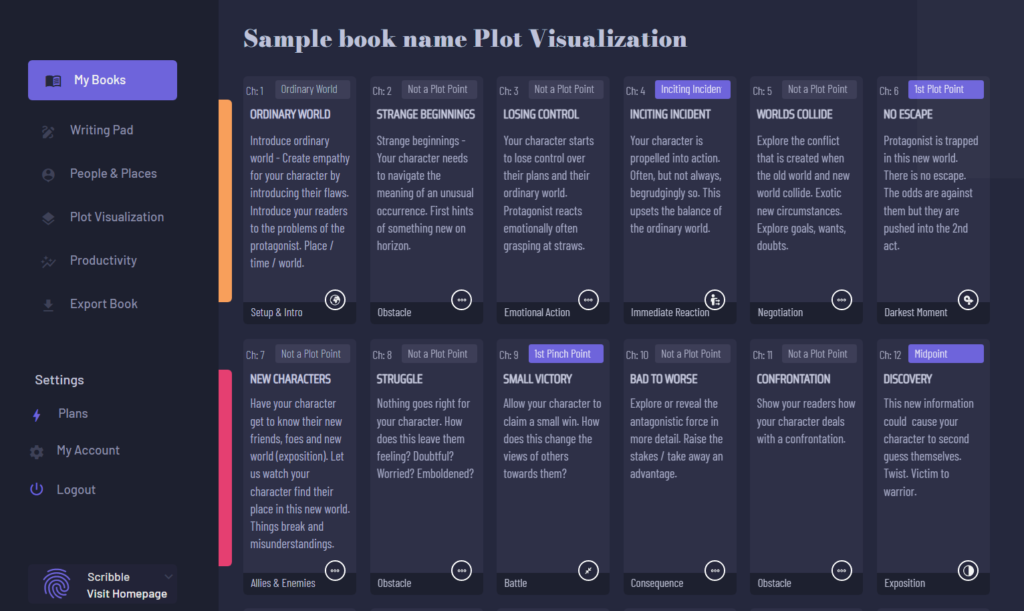
At a minimum this serves as a tentative framework which I can breathe life into through writing. But adding chapter names and building this basic structure, with short chapter summaries helps me avoid having those days when I’m staring at the screen not knowing where to take my story. If you’re the type of person who finds themselves paralized by the overwhelming number of narrative options available to you, then pre-plotting a story might be helpful for you. You can learn more about our 24 chapter plot template here. This will get your plot up and running in under 5 minutes.
Another major issue I see is a fear of your first draft not being an A+. Again, there are many ways to deal with this, but one way is to give yourself permission to have your first draft sit somewhere between a B- and a B+. Just get your main ideas written down and you can always re-write later bumping your B up to an A.
Another major obstacle is not conditioning your work environment for productivity. You need to avoid interruptions and create as motivating an environment as possible.
Another hurdle that authors face is dealing with lack of consistency in their routines and processes.
Another is their inability to isolate their focus to one thing at a time.
And lastly, another big one I see all of the time is writer’s doubting themselves. Writers themselves are often their own obstacles. They believe in old versions of themselves or have negatively skewed misconceptions about their skills and these attitudes hold them back.
Now, this is just a small sample of obstacles writers face, but essentially, the better you are at identifying these problems and planning what you’ll do when these problems arise, the better chances you’ll have of not being thrown off course when these problems do arise.
Also, practice handling these obstacles out of context. Say to yourself, “if this, then that”. So “if I have writer’s block at the end of a chapter, I’ll do “this”. “If my kids, friends or spouse interrupt my writing.. I’ll do this”. “If I feel tired and don’t want to write… I’ll do this”. Visualize, in as much detail as possible, these things happening, and how you’ll deal with them, over and over, so when these things do happen, you’ve essentially, pre- programmed yourself to act in a personally beneficial way so that you don’t go off course.
Plan Your Writing
The last step of the WOOP process is planning. Again, in our example, we did a lot of this planning upfront. Remember, that my SMART goal stated that I will write 2500 words / day. Not only can I easily check my word count within Scribble, but when I’m writing a chapter, as I add new text my writing progress bars (both my chapter progress and overall book progress) will update in real time.
This is important to be able to zoom in and zoom out. Here at the top of my page, for example, you see my progress towards completing my target of 60,000 words. This progress bar will move slowly over the course of the month. Many writers find this slow process discouraging. That’s why it’s nice to see a chapter progress bar which you see over to the right, which monitors how far I’ve come today. I know I can get this progress bar to 100% by the end of the day today, and it feels great when I hit that daily-target.
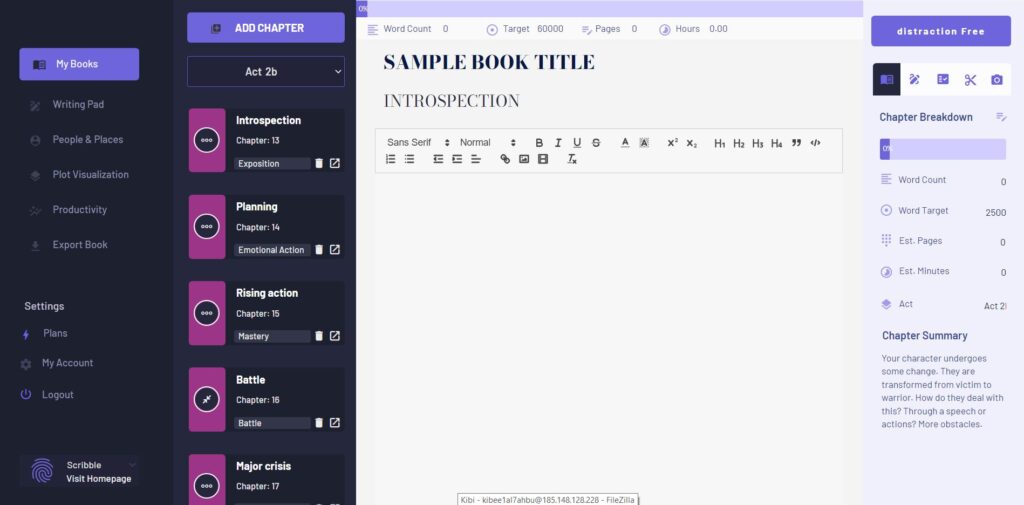
Conclusion: How to Write a Book in 30 Days
So is it possible to write a novel in under a month? In short, the answer is yes, at least a first draft. At the end of the day, it’s going to boil down to tenacity. You just need to show up and do the work day in and day out.
To help keep you anchored and to help you “lock in” your destination, it’s easy enough to schedule a couple minutes / day to complete the SMART planning and WOOP visualization exercises covered in this tutorial. Again, in the studies shown in the Yale course, daily WOOPing often improved goal actualization by a multiple of 2 or even 3 in some cases. I know that “visualization” techniques can often seem a bit far out, but it turns out that empirically speaking, these strategies work.
So that’s all I have for you today. If you want to use the writing tools showcased in this tutorial you can simply sign up here.
Thanks for stopping by today!

We Help You Keep it All in Your Head
![]() Software version 1.4.1
Software version 1.4.1

A software solution designed to help writers complete compelling stories.
 Version 1.8.0
Version 1.8.0
PRODUCT
All Features
Pricing
Productivity
Story Structure
World Building
Character Building
USE CASES
Novels
Essays
Memoirs
Reports
Kids Books
